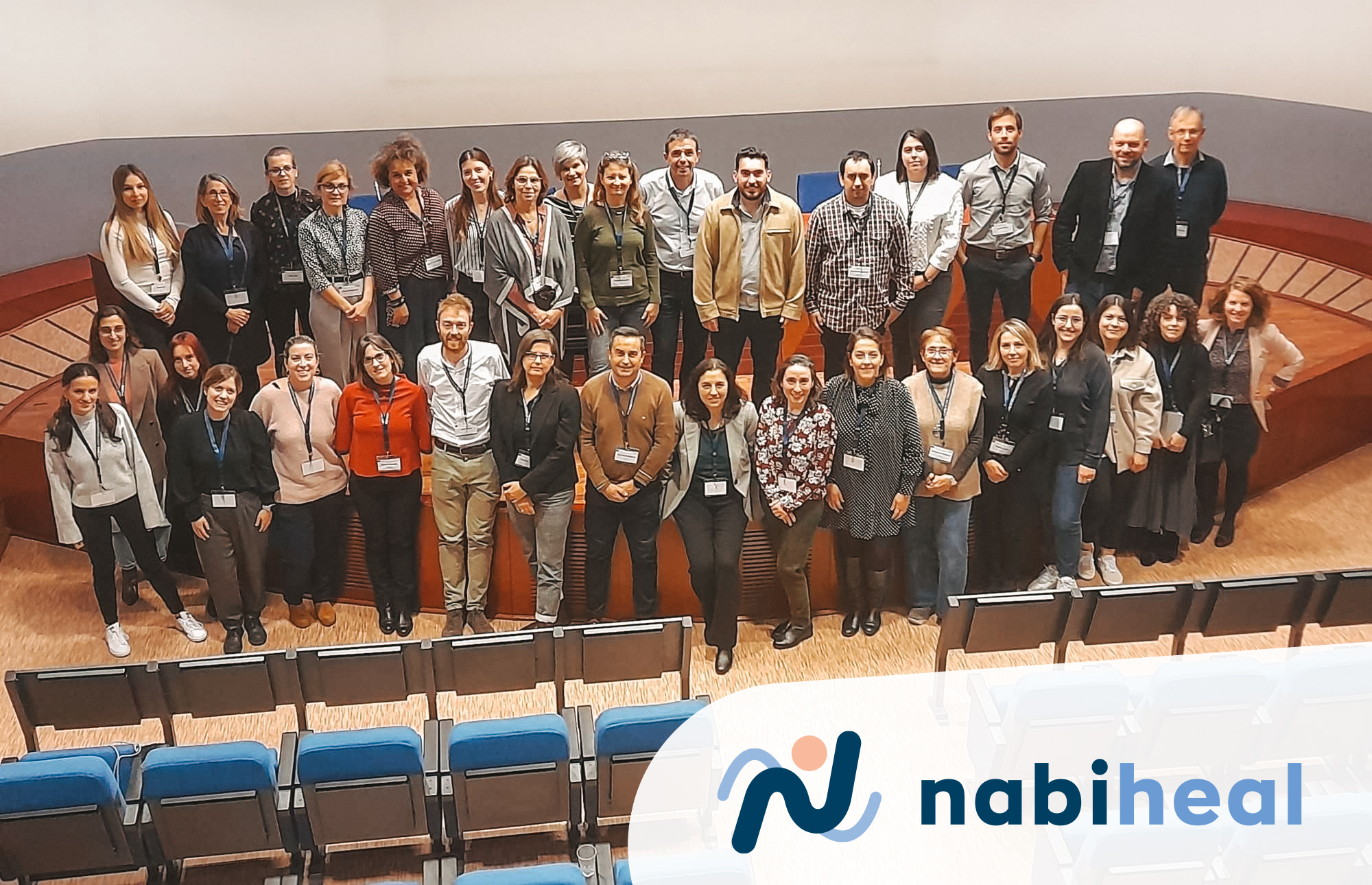Today is the international day of rare diseases, a day to raise awareness and instigate change for people living with a rare disease. From NANBIOSIS we want to sume to this celebration and higtligh our commitment to helping people with rare diseases through research.
Dr. Ibane Abasolo, Scientific Director of NANBIOSIS U20, was at the WORLDSymposia conference last week in Orlando (FL, USA), where the latest advances in preclinical study and clinic of lysosomal storage diseases were explained. There, she presented the results obtained in the Smart4Fabry project coordinated by the CIBER-BBN where nanoliposomes were developed for the treatment of Fabry disease. The work, entitled “Preclinical Validation of Nanoliposomes for ERT for Fabry disease”, was a result of the collaboration of the groups of Dr. Ventosa and Dr. Corchero, both from CIBER-BBN, and the participation of units U1, U3, U6, and U20 of the ICTS Nanbiosis.
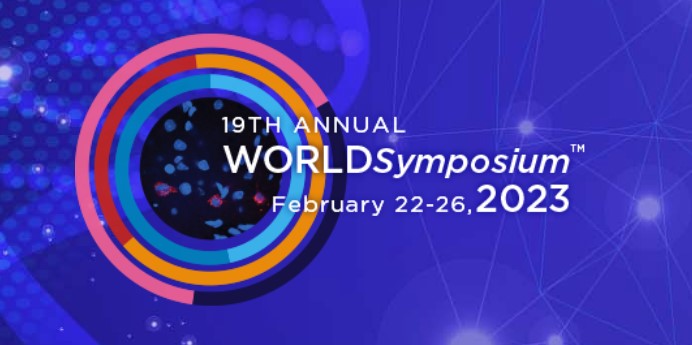
In addition, today Dr. Abasolo participated in the Nano Rare Day session, organized by the NanoMedSpain platform and the Barcelona Bioengineering Institute (IBEC) at the Sant Joan de Deu Hospital in Barcelona, presented the work entitled “Use of natural and artificial nanoparticles for the treatment of lysosomal storage diseases”, where in addition to nanoliposomes, she also detailed how extracellular vesicles can be a good vehicle to improve replacement enzyme therapy in lysosomal diseases.
Also Dr. Juan Pablo Salvador from NANBIOSIS U2 CAbS has presented at in the Nano Rare Day session his talk on “Quorum Sensing to improve the management of cysticfibrosis“, explaining the difficulty of quickly identifying bacterial infections, which are common in patients with Cystic Fibrosis. In this sense, “Quorum Sensing”, a microbial communication mechanism through which the cells themselves regulate the expression of genes based on cell density, can help identify biomarkers and improve the management of cystic fibrosis.
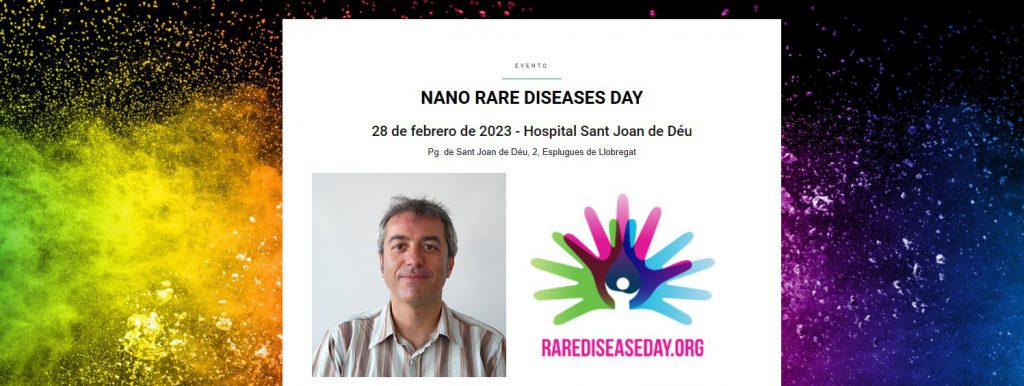
Related news: Fabry Desease in the Rare Disease Day: A New Hope
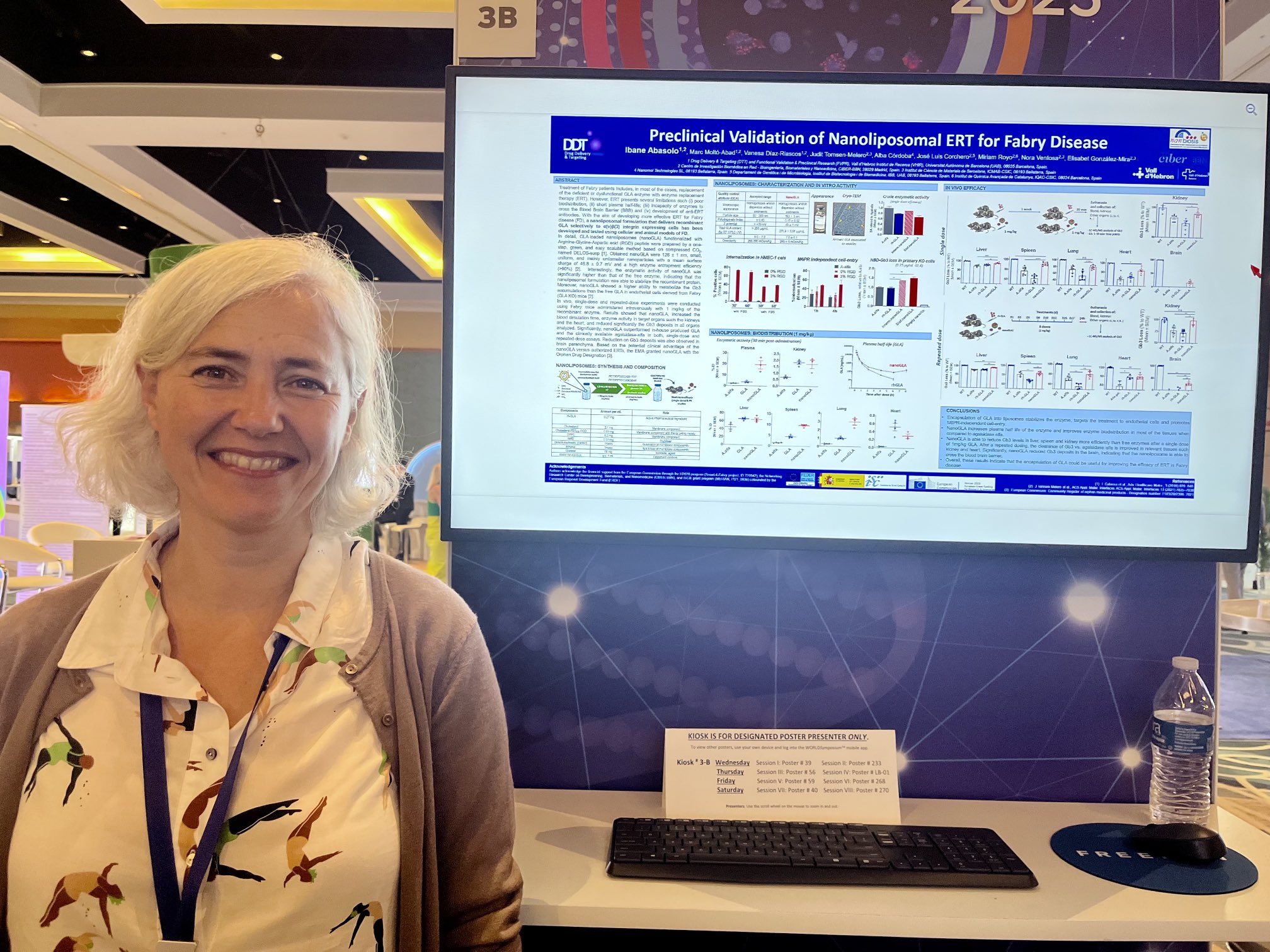
Several CIBER-BBN groups at the University of Barcelona, the Institute for Advanced Chemistry of Catalonia (IQAC-CSIC), the Institute of Microelectronics of Barcelona (IMB-CNM-CSIC) and the Institute of Nanoscience and Materials of Aragon (INMA) —a joint institute of the CSIC and the University of Zaragoza (UNIZAR)— have developed a new method for detecting RNA viruses based on the technology of using probes that form triplex structures. This innovative methodology opens up new options to detect viruses such as SARS-CoV-2, the influenza A (H1N1) virus or the respiratory syncytial virus (RSV), a pathogen that affects newborns and requires differential diagnostic care.
This interdisciplinary work, published in the International Journal of Molecular Sciences, is led by Carlos J. Ciudad and Verónica Noé, from the Faculty of Pharmacy and Food Sciences and the Institute of Nanoscience and Nanotechnology (IN2UB) of the University of Barcelona ; Ramón Eritja, Anna Aviñó, Lluïsa Vilaplana and M.Pilar Marco, from IQAC-CSIC and CIBER-BBN; Manuel Gutiérrez, Antoni Baldi and César Fernández, from the IMB-CNM-CSIC, and Valeria Grazu and Jesús Martínez, CSIC researchers at the Institute of Nanoscience and Materials and Aragon INMA (CSIC-UNIZAR) and CIBER-BBN.
The research has counted with the expertise of two NANBIOSIS Units from CIBER-BBN and IQAC-CSIC; NANBIOSIS U2 Customized Antibody Service (CAbS), led by Pilar Marco and Nuria Pascual, and U29 Oligonucleotide Synthesis Platform (OSP), led by Ramón Eritja and Anna Avinó.
This research work was carried out in the context of the PoC4CoV project, led by M. Pilar Marco and César Fernández and financed through the Interdisciplinary Thematic Platform of Global Health of the CSIC. Subsequently, the research has continued as part of a project financed by La Marató de TV3 in 2020 to fight against COVID-19 in which experts from the Faculty of Chemistry of the UB also participate.
Polypurine tweezers to capture viral RNA
The new methodology is based on the ability of polypurine tweezers (PPRHs) —designed by the UB cancer therapy group— to capture viral RNA and form a high affinity triplex. When this hybrid structure is connected to a molecular probe and is brought into contact with the affected patient’s sample, a viral agent detection signal is obtained. The method now presented in the scientific publication has been called the Triplex Enhanced Nucleic Acid Detection Assay (TENADA).
“PPRHs are unmodified single-stranded DNA hairpins that are made up of two mirror domains of antiparallel polypurines. These domains, connected to each other by a thymidine loop, are linked by intramolecular reverse Hoogsteen bonds. Molecular tweezers can specifically bind to polypyrimidine sequences in single-stranded (ssDNA), double-stranded (dsDNA) or RNA viruses through Watson-Crick bonds, thus forming an antiparallel triplex”, details Professor Carlos J. Ciudad, from the Department of Biochemistry and Physiology of the UB.
An effective and faster methodology than the PCR test
Among the advantages that it presents in the detection of viral RNA, it should be noted that the PPRHs methodology can be applied without the intervention of reverse transcriptase —the enzyme that converts RNA into DNA— or the thermocycler (the device that amplifies the material samples). DNA with polymerase chain reaction or PCR). In addition, it has a sensitivity and specificity equivalent to that of the PCR test and can provide results in less than an hour.
In the framework of the work, the team used the hybridization sandwich format in various biosensing devices. This approach uses two oligonucleotides: a triplex-forming PPRH hairpin to serve as the capture probe, and a labeled duplex-forming DNA oligonucleotide to serve as the detection probe.
“The triplex-forming PPRH hairpins were designed to bind to SARS-CoV-2 polypyrimidine sequences, while the detection probes were designed to complement a region near the polypyrimidine target site. Thus, the presence of SARS-CoV-2 RNA is detected by the formation of the ternary complex on the surface of the biosensor”, details Professor Verónica Noé (UB-IN2UB).
This methodology has been implemented in a compact electrochemical device that integrates an electrochemical cell with two electrodes on a chip —manufactured in the Micro and Nanofabrication White Room of the IMB-CNM-CSIC— and a paper fluidic component, and in a Lateral thermal flow implemented in nitrocellulose and using plasmonic nanoparticles and thermal paper that has been developed at the INMA (CSIC-UNIZAR).
TENADA: applications in biomedical research
PPRHs are described in the scientific literature as gene silencing tools for various genes mainly involved in cancer. In addition, they have also been incorporated as probes in biosensors for the detection of small RNA molecules (micro-RNA) to determine the state of DNA methylation and for the diagnosis of pneumonia caused by the fungus Pneumocystis jirovecii.
Now, the new TENADA methodology proves to be effective not only in the detection of viral particles. The high affinity of PPRHs for viral RNA is a property that can be applied to inhibit the virus replication process. For this reason, the antiviral properties of CC1PPRH and CC2PPRH polypurine clamps in cells of the VeroE6 lineage infected with SARS-CoV-2 virions are now also being studied.
In parallel, the work of the different groups involved has also been the basis of a technology that was patented and licensed in July 2022 through the participation of the UB Patent Center, the CSIC and the CIBER-BBN. In turn, this patent has been licensed non-exclusively to the Spanish company Nanoinmunotech through the management of the Bosch i Gimpera Foundation (FBG-UB) in the technology protection process and the company’s license agreement. .
Article of reference:
Aviñó, A.; Cuestas-Ayllón, C.; Gutiérrez-Capitán, M.; Vilaplana, L.; Grazu, V.; Noé, V.; Balada, E.; Baldi, A.; Félix, A.J.; Aubets, E.; Valiuska, S.; Domínguez, A.; Gargallo, R.; Eritja, R.; Marco, M.-P.; Fernández-Sánchez, C.; Martínez de la Fuente, J.; Ciudad, C.J. «Detection of SARS-CoV-2 Virus by Triplex Enhanced Nucleic Acid Detection Assay (TENADA)». International Journal of Molecular Sciences, diciembre de 2022. Doi:10.3390/ijms232315258
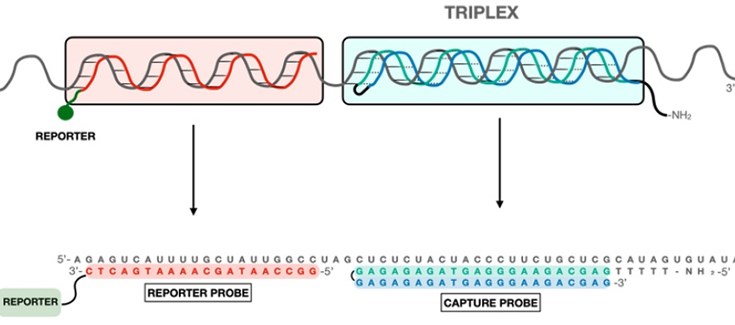
CIBER Centro de Investigación Biomédica en Red (Consortium for Biomedical Research Network), one of the ICTS NANBIOSIS nodes to which 18 of its 26 units belong, presents the new institutional video “CIBER is Collaboration”
This video puts a face to the scientific activity of CIBER researchers and highlights CIBER capacity for synergy. CIBER researchers speak about the main research lines of its 13 subject areas and highlights the collaboration between its more than 500 groups and more than 6,000 researchers belonging to more than 100 institutions of different natures that make up CIBER: hospitals, research centers, universities, foundations, etc.
The ICTS NANBIOSIS, created between CIBER and the Jesús Usón Minimally Invasive Surgery Center in 2014, (to which Bionand joined in 2019 as a third node), is a clear example of CIBER’s capacity for synergy, bringing together 3 nodes and 26 units or platforms research to provide cutting-edge solutions to the problems faced by researchers in bio and nanomedicine.
Likewise, the video highlights some of the most relevant CIBER projects as well as the importance of technology transfer and scientific dissemination.
The researcher Elisabeth Prats is one of the “faces” in the video. She is part of the NANBIOSIS Unit 8 Micro– Nano Technology Unit at IMB-CNM CSIC
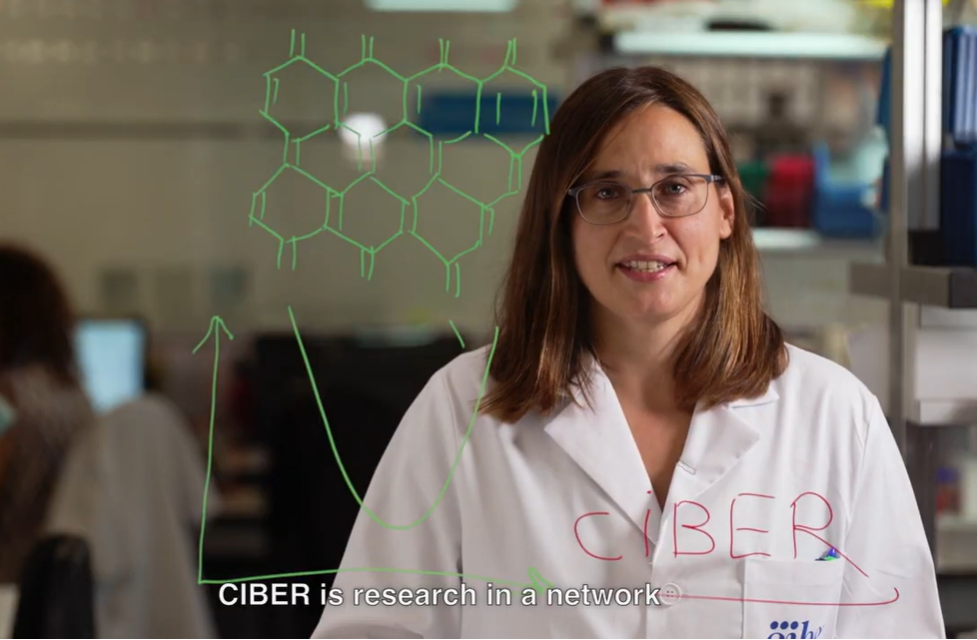
Prof Nora Ventosa, Scientific Director of NANBIOSIS U6 “Biomaterial Processing and Nanostructuring Unit” from CIBER-BBN and ICMAB-CSIC) is hosting the Lecture on nano-pharmaceuticals: “Advancing a novel nano-pharmaceutical towards clinical translation” by Elisabet González, from Nanomol-Bio Group of ICMAB-CSIC and CIBER-BBN
Monday, 13 February 2023
12 PM – 15 PM
ICMAB – Sala d’Actes Carles Miravitlles and ONLINE
Registration and futher information
Abstract: Nano-pharmaceuticals have the potential to drive the scientific and technological uplift, offering great clinical and socio-economic benefits to the society in general, industry and key stakeholders and patients. However, the translation of nano-pharmaceuticals from lab bench to an advanced stage of pharmaceutical development faces significant challenges: the high quality and quantity of these novel nanoformulations required for the preclinical (and further clinical) testing, the tight standards and regulations that must be complied with in this pharmaceutical field, and the increasing costs as development progresses, entails the major challenges, especially considering that the main players are usually research groups, spin-offs from academia or SMEs.
In this context, publicly funded research investment led by the European Commission within the framework of the Horizon Europe Programme is contributing to foster the transition from basic science to clinical practice. For example, by means of the EUH2020 Smart-4-Fabry Project (2017-2020), a novel nanomedicine for the Fabry disease treatment was developed up to an advance stage of preclinical development. For that, crucial considerations for early-stage product development were taken into account: these included identifying those critical quality attributes of the drug product essential for activity and safety, development and validation of advanced analytical methods (physical, chemical, biological) for characterization and quality control, identification and control of process parameters to ensure consistent batch-to-batch reproducibility, up-scaling manufacturing, and the use of adequate preclinical models.
Additionally, close collaboration with regulatory agencies from the early stages of development was carried to assure an aligned position and obtain a solid proof-of-concept. The outstanding efficacy results in preclinical models permitted to obtain an important milestone with strong implications for the translation of this new therapeutic product from bench to bedside: the Orphan Drug Designation by the European Medicines Agency (EMA). Currently, with the EU H2020 Phoenix Project (2021-2025), which aims to establish a Pharmaceutical Open Innovation Test Bed, together with the Project Innova4Fabry (2022-2023) from Innovators program (AGAUR), which aims to create a spin-off company, a smooth transfer of this novel therapy to clinical phase is pursued.
Dr. Elisabet González is senior researcher at the Nanomol-Bio group from ICMAB-CSIC and CIBER-BBN. She has extensive training in the field of Pharmaceutical Sciences. After the graduation of BSc in Pharmacy (2003), she held the MSc in Drug Research, Development and Control (2007), and the PhD in Pharmacy from the University of Barcelona (UB) (2011). Her 15+ years of scientific activity have been focused on the design of new type of nanoparticulate systems for technologically advanced applications in biomedicine (ocular and dermal inflammatory diseases, complex wounds, rare congenital metabolic diseases…).
Her pharmaceutical expertise has contributed to manage and coordinate multidisciplinary activities in the frame of national and international projects, which cover all key stages of the pharmaceutical development: from the design, manufacturing, characterization and quality control of nanoformulations to the preclinical and clinical development, and regulatory considerations. To highlight, she has played a key role in advancing the development of two effective nanoformulations from an experimental proof of concept (TRL3) to an advanced stage of preclinical development (TRL5), enabling with her first hand scientific-technical coordination the entrance of these nanoformulations to the regulatory preclinical phase.
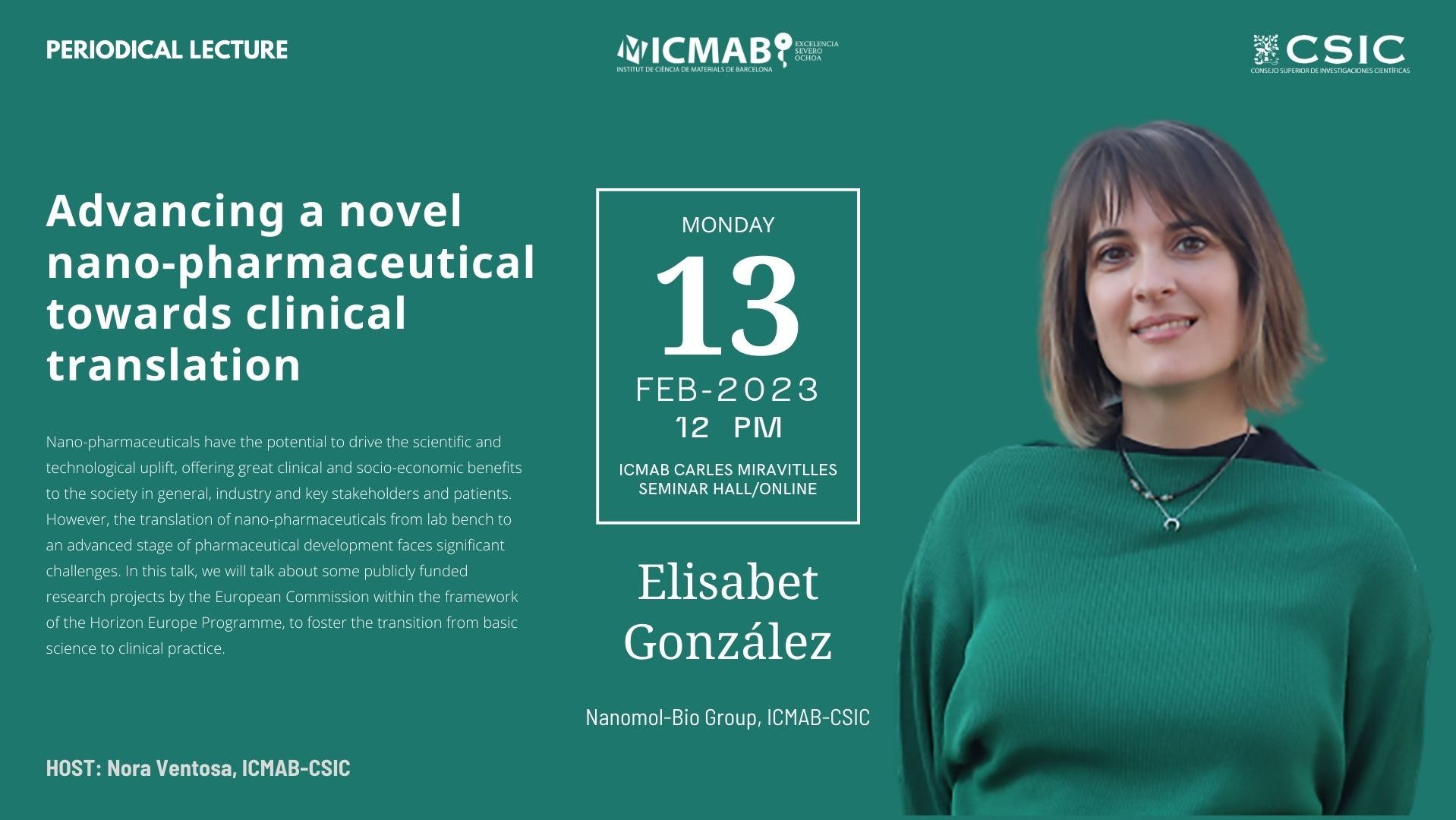
Cáceres, 31st January 2023
On the occasion of the training course in Assisted Reproduction that is held today at the CCMIJU facilities, within the Master’s Degree in Advanced Biotechnology (MUBA), organized by the University of Extremadura in collaboration with the CCMIJU, two systems of recent acquisition are handled within the framework of the project “Embryonic Genetics in Assisted Reproduction” (GENERA), co-funded by the European Regional Development Fund (FEDER) within the Spain’s Pluriregional Operational Program for Singular Scientific and Technical Infrastructures (ICTS) 2014-2020 and by the Consejería de Economía, Ciencia y Agenda Digital of the Junta de Extremadura.
The above mentioned systems are a Piezoelectric Micromanipulator that allows the introduction of needles or capillaries into the cells for subsequent microinjection, and a Time-lapse Incubator to regularly observe embryos, perform precise evaluations, and minimize embryonic culture stress. Both are installed in the assisted reproduction laboratory of the CCMIJU and are being used by 10 master’s students to carry out their practices.
The project has an eligible budget of €98,000, of which the ERDF co-financing rate (80%) amounts to 78,400 and the national contribution to €21,600. It is expected to be completed in June 2023.
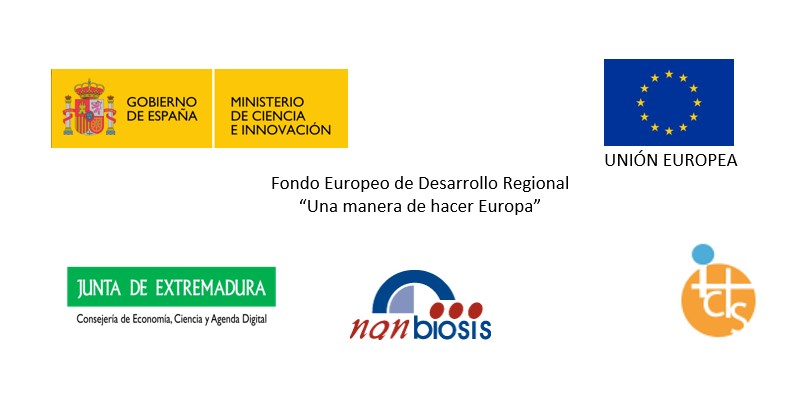
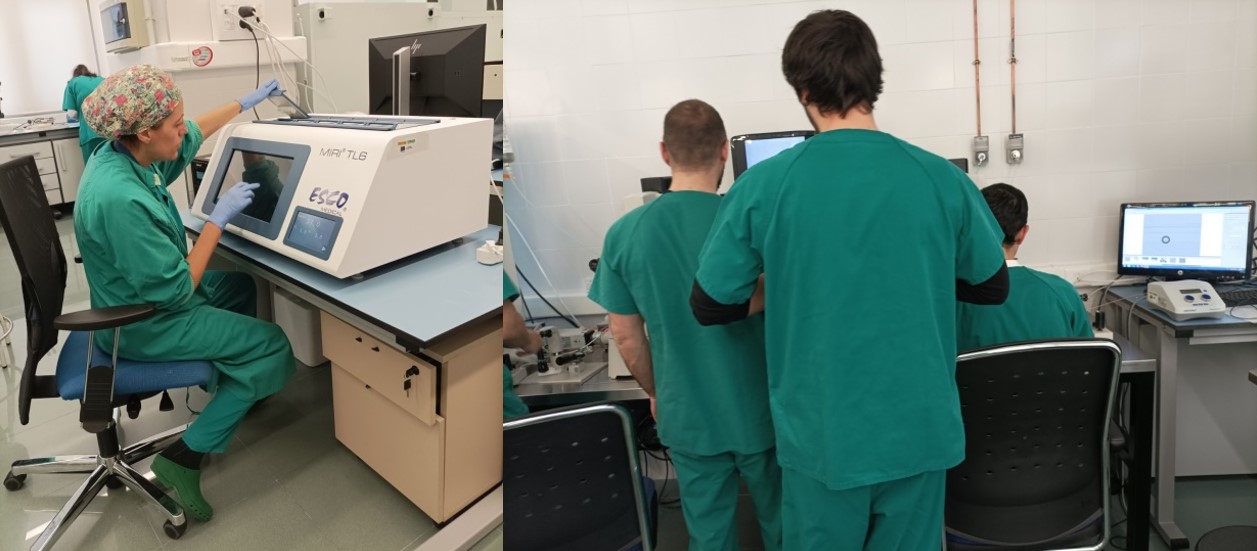
NANBIOSIS is a Research Infrastructure for Biomedicine made up of the Platforms of the Center for Centro de Ivesntigación Biomedica en Red (CIBER- in the area of Bioengineering, Biomaterials, and Nanomedicine -CIBER-BBN), the Preclinical Infrastructure and the Development of Minimally Invasive Technologies, of the Jesús Usón Minimally Invasive Surgery Center (CCMIJU) and the Nanoimaging unit of the Biomedical Research Institute of Malaga-Nanomedicine Platform (IBIMA-BIONAND Platform).
NANBIOSIS as part of the Spanish Map of ICTS (an acronym for “Scientific and Technical Unique Infrastructures” in Spanish), approved by the Ministry of Science and Innovation, is open to all interested national and international users who may come either from the public or the private sector, and who can apply for access under the “Competitive Open Access” or “Access on Demand” modalities.
The 20% of the NANBIOSIS Units’ capacity will be granted on the Competitive Open Access modality and will be prioritized according to criteria of scientific and technical quality and singularity of the proposals.
There will be 2 calls per year for open and competitive access that will allow the prioritisation of the best service proposals. Here you have the details of the first call: https://www.nanbiosis.es/call/
The call will open on February 1 and applications can be submitted throughout the whole month (due date February 28th). Access application forms submitted after that date will be processed as “access on demand” applications.
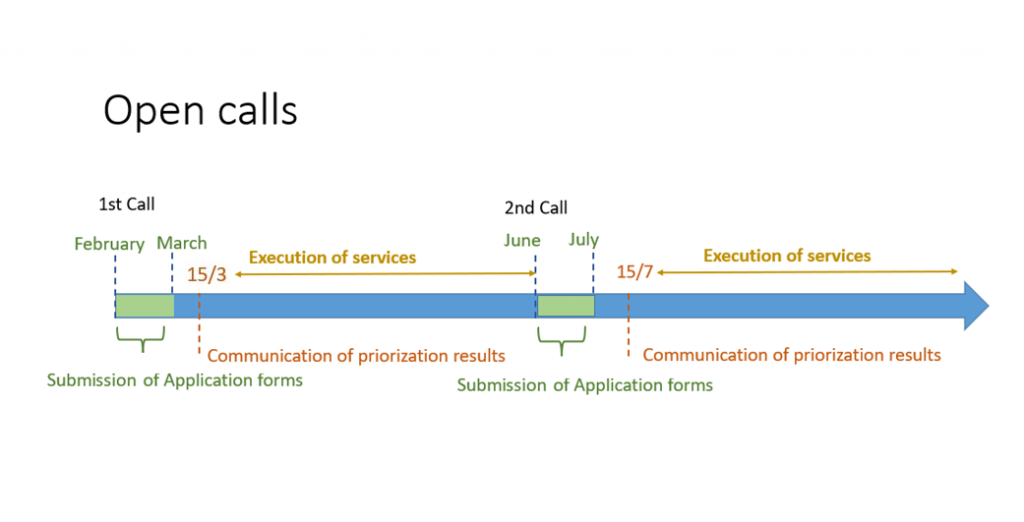
Proposals granted in the open and competitive access modality must meet, at least, one of the circumstances listed in the access application form (“order request“), in order to demmonstrate their scientifc and technical quality or singularity.
Thus, for example, applications related to R&D projects funded through national or European calls are eligible, as well as the need to carry out one of the NANBIOSIS “Cutting-Edge Biomedical Solutions” that implies the interaction of several Units, among others.

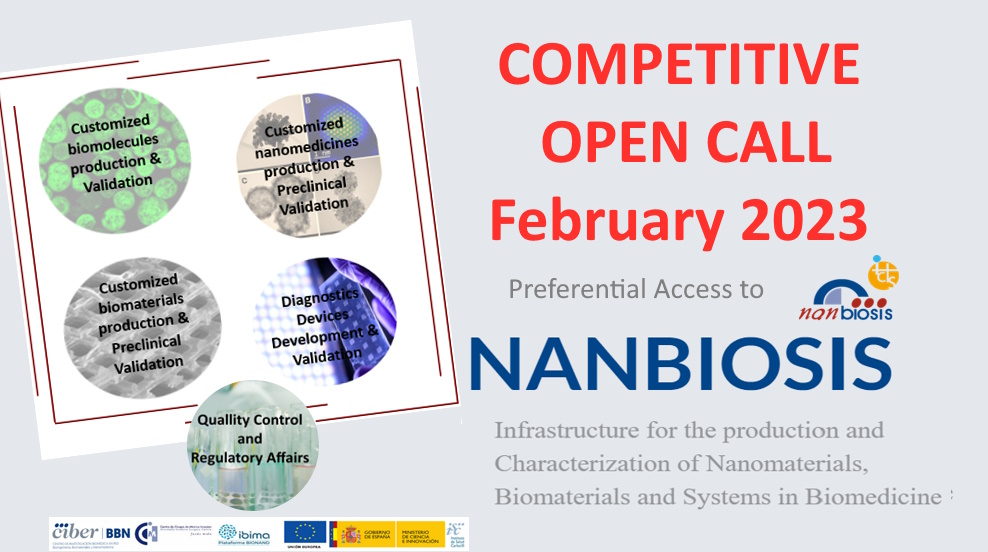
Researchers of three groups of CIBER-BBN at CSIC and IBEC, have created a versatile platform based on hierarchically nanostructured RGD peptide using quatsomes, with proved enhanced cell adhesion. These findings, which arose within the framework of the intramural project of CIBER-BBN “Molecular Biointerfaces for cell guidance” (DynaMo4Vasc), open new possibilities for tissue engineering.
The participation of two NANBIOSIS units were acknowledged in the publication of the research results: the synthesis of RGD derivatives were performed at NANBIOSIS U3 “Synthesis of peptides unit” of CIBER-BBN at IQAC−CSIC. And the design and characterization of quatsomes were done at U6 of NANBIOSIS “Biomaterial Processing and Nanostructuring Unit” of CIBER-BBN at ICMAB-CSIC.
Tissue Engineering and cell adhesion
Tissue engineering pursues the development of functional and easy biological substitutes that allow restoring damaged organ or tissue or maintaining their normal function. The newer approach is the combination of appropriate cells and growth factors with a scaffold that supports the tissue or organ.
The scaffold is crucial since it must provide the conditions and the environment for the adequate cell regulation (adhesion, migration, proliferation, and differentiation), as well as the adequate delivery of bioactive factors (growth and adhesion), so that cells form the new tissue with its proper structure and function.
Cell adhesion (the interaction of the cells with its surroundings) is an important phenomenon for the development of appropriate scaffolds for tissue engineering, as it can ultimately determine cell fate. Thus, the study of the factors that govern cell adhesion and its optimization is essential.
The tripeptide Arg-Gly-Asp (RGD) is the most common peptide responsible for cell adhesion. Although the studies of its surface density and spacing at nanoscale have already shown a significant influence on cell adhesion, the impact of its hierarchical nanostructure is still unexplored.
Quatsomes
Quatsomes are non-liposomal nanovesicles which have been shown to be very homogeneous and stable in different media and which can be easily tuned with a wide range of chemical functionalities.
The Nanomol Group (from CIBER-BBN and ICMAB-CSIC) has been working during the last years with these nanoparticles showing their suitability for applications in nanomedicine, (as nanocarriers and nanocontainers to encapsulate drugs and protein cargoes, or as fluorescent dyes for therapy and diagnostics). This expertise led the researcher to explore the integration of quatsomes with relevant molecules and their use once anchored to a surface.
RGD Nanoarchitecnonics
Nanoarchitectonics is a novel concept that refers to multicomponent systems organized through the supramolecular union of nanometer structures where the main players are not the individual nanoparticles but their interactions, giving rise to new functionalities.
The team of researchers developed a versatile platform based on quatsomes as an effective nanoscopic building block to achieve hierarchical nanostructures of the RGD peptide which were further anchored to gold substrate. In comparison with substrates featuring a homogeneous distribution of RGD peptides, the resulting hierarchical nanoarchitectonic surfaces dramatically enhanced cell adhesion.
These findings open many possible pathways for the understanding of cell behaviour and improve the performance of clinical applications like implants and tissue engineering.
Article of reference:
Marc Martínez-Miguel, Miquel Castellote-Borrell, Mariana Köber, Adriana R. Kyvik, Judit Tomsen-Melero, Guillem Vargas-Nadal, Jose Muñoz, Daniel Pulido, Edgar Cristóbal-Lecina, Solène Passemard, Miriam Royo, Marta Mas-Torrent, Jaume Veciana, Marina I. Giannotti, Judith Guasch, Nora Ventosa, and Imma Ratera. “Hierarchical Quatsome-RGD Nanoarchitectonic Surfaces for Enhanced Integrin-Mediated Cell Adhesion” ACS Appl. Mater. Interfaces 2022, 14, 42, 48179–48193 Publication Date:October 17, 2022 https://doi.org/10.1021/acsami.2c10497
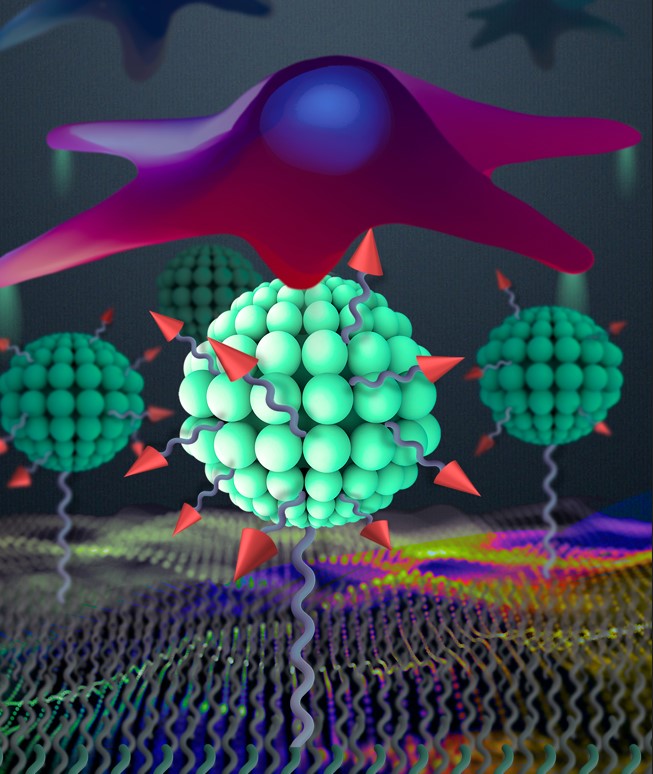
The ICTS NANBIOSIS has expanded its capabilities with the installation and commissioning of a new equipment Time-Lapse Incubator in the CCMIJU’s Assisted Reproduction Lab.
The acquisition of the Time-Lapse Incubator is part of the project “Embryonic Genetics in Assisted Reproduction” (GENERA), co-funded by the European Regional Development Fund (ERDF) within the framework of Spain’s Plurirregional Operational Program for Singular Scientific and Technical Infrastructures (ICTS) 2014 -2020 and by Consejería de Economía, Ciencia y Agenda Cultural of Junta de Extremadura.
The objective of GENERA includes the purchase of lab equipment to expand services in the field of embryonic genetics as well as creating, editing and making traceability of embryos with high genetic value.
The first lab equipment acquired is the EPPENDORF PiezoXpert Piezoelectric-assisted micromanipulator that supports the creation and possible embryo editing, allowing easy penetration into cells for subsequent microinjection or micromanipulation.
The second one is the Time-Lapse Incubator that enables observation of embryos for accurate assessments and minimizing embryo culture stress.
The purchase of this lab equipment will offer the possibility of developing next-generation embryos, being able to face specific studies of the highest reproductive level and offering studies demanded by companies in the sector.
The project has an eligible budget of €98,000, of which the ERDF co-financing rate (80%) amounts to 78,400 and the national contribution to €21,600. It is expected to be completed in June 2023.

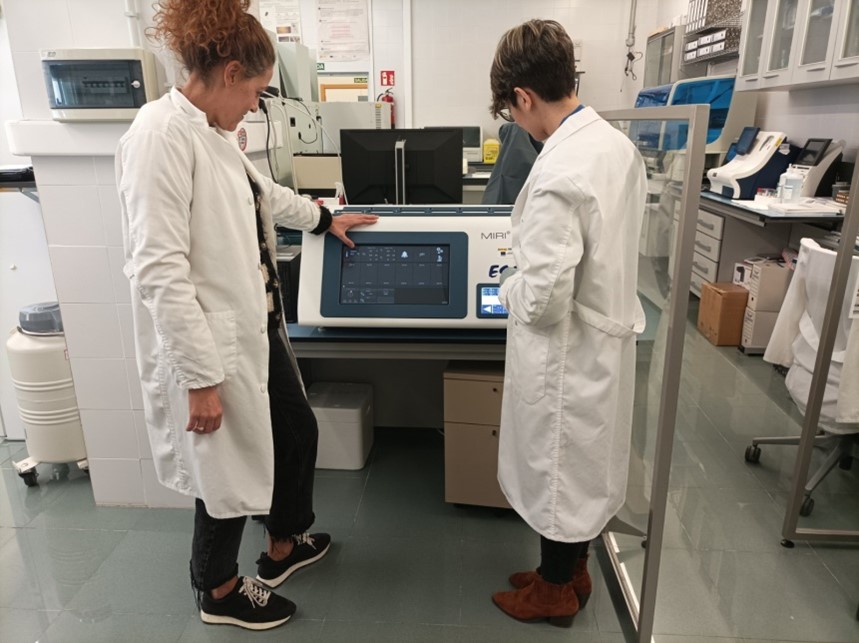
The Horizon Europe project NABIHEAL, coordinated by the Center for Biomedical Research Network (CIBER) at the Institute of Materials Science of Barcelona (ICMAB-CSIC), was launched on 11-12 January 2023 in Barcelona with the first meeting of the international consortium, formed by 14 partners from 7 countries, including research centers, universities, and private companies.
This project will apply one the “Cutting Edge Biomedical Solutions” of NANBIOSIS for the preparation of different nanoestructures with antimicrobial properties, required for the development of the final multifunctional wound healing biomaterials. This case will gather the expertise of two NANBIOSIS unit: NANBIOSIS U6 will produce and characterize these nanoestructures with antimicrobial properties, which will be tested in NANBIOSIS U16.
NABIHEAL stands for “Antimicrobial Nanostructured Biomaterials for Complex Wound Healing” and is funded under the Horizon Europe Research and Innovation programme with a total budget of nearly 5 million euros over four years. NABIHEAL aims at solving two unmet medical needs in complex wound healing: on the one hand, affordable treatments for wound infections and prevention of complications during wound healing, and on the other, a strategy to optimize the composition and efficacy of wound dressings.
The kickoff meeting, held at the CSIC Researcher’s Residence in Barcelona, was opened by the project coordinator, Nora Ventosa, from CIBER and ICMAB-CSIC, and by institutional and political representatives, including Riccardo Rurali, Vice-Director of ICMAB-CSIC; Ramon Martínez Mañez, Scientific Director of CIBER-BBN; Jordi Aguasca, Director of Technological Transformation and Disruption Unit, ACCIÓ; and Xavier Aldeguer, General Director of Society of Knowledge, Transfer & Territory of the Catalan Government. The meeting provided the opportunity to interact in person with all the consortium partners and establish the first collaborative activities to ensure timely delivery of the project milestones.
The NABIHEAL project will advance on the synthesis of advanced nanostructured biomaterials as an alternative to the commonly used silver-based materials. “The project will work to produce multifunctional materials for the treatment of complex wound healing, which has become a global health problem. For example, in developed countries, it affects the quality of life of more than 2% of the total population,” affirms Nora Ventosa, coordinator of the project.
Complex wounds, such as chronic wounds, are highly susceptible to microbial infection and biofilm formation, and thus difficult to treat. The most common antimicrobial products to treat these infections are based on silver. However, they have several economic, environmental and safety drawbacks. The biomaterials developed within the NABIHEAL project will offer a safer, more sustainable and more cost-effective alternative.
The project aims to obtain innovative multifunctional wound healing biomaterials using affordable EU-based manufacturing technologies. In the long term, NABIHEAL could become a game-changing alternative to silver in wound healing dressings.
The goals of the project will be tackled by an interdisciplinary consortium from 7 countries, combining expertise in different areas, such as synthesis and characterization of biomaterials, biocompatibility and safety, regulatory aspects and ethics, or wound healing product development and scale-up. “We are excited to launch this project, in which 8 academic institutions and 6 private companies will join forces to face the challenging problem of complex wound treatment,” adds Prof. Ventosa.
In addition to the Center for Biomedical Research Network (CIBER) at the Institute of Materials Science of Barcelona (ICMAB), as coordinator, the international consortium is formed by the following centers and companies: from Spain, the Center for Biomedical Research Network (CIBER) at the University of Extremadura and the University of Cantabria, the Spanish National Research Council (CSIC), Nanomol Technologies S.L. (NT), Bioiberica S.A.U (BIO), Histocell S.L (HCELL), the University of Granada (UGR), and Asphalion (ASPH); from Germany, MyBiotech GmbH (MyB) and Charité-Universitätsmedizin Berlin (CH); from Croatia, the Institute for Medical Research and Occupational Health (IMI); from Denmark, the Aarhus University (AU); from Israel, the Technion-Israel Institute of Technology (IT); from Austria, BioNanoNet Forschungsgesellschaft mbH (BNN); and from Slovenia, the University of Maribor (UM).
More information:
Prof. Nora Ventosa, Project Coordinator, CIBER, ICMAB-CSIC ventosa@icmab.es
Caitlin Ahern, Communication, BioNanoNet caitlin.ahern@bnn.at
